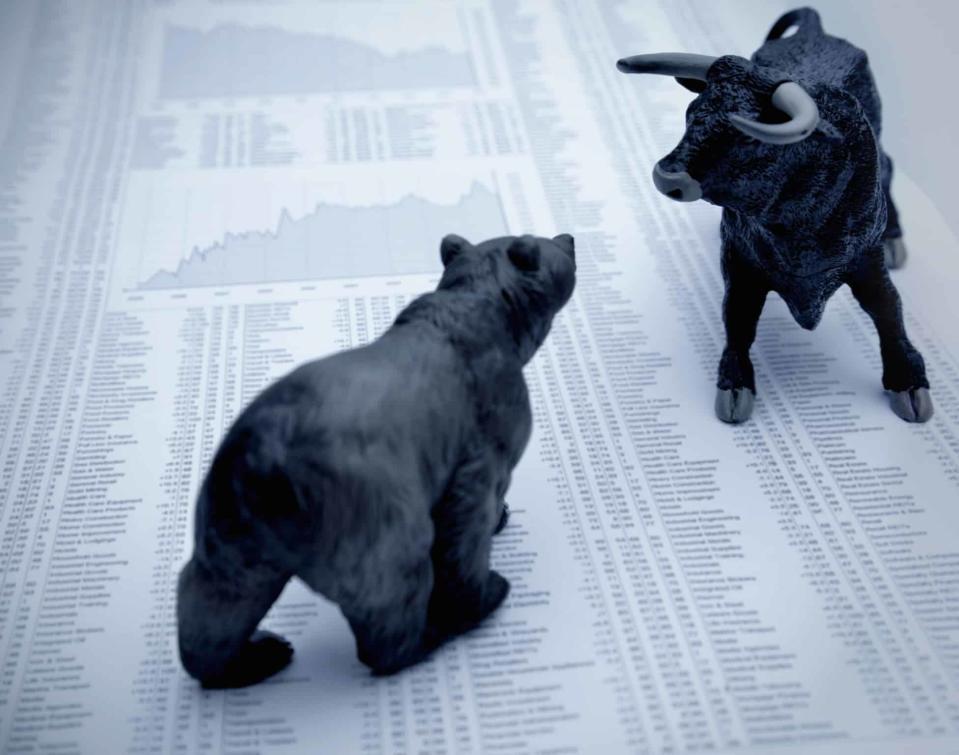Why a Bearish Market Could Be the Best Time to Start Investing

Written by Brian Paradza, CFA at The Motley Fool Canada
Popular investing legend Warren Buffett famously encouraged investors to “be fearful when others are greedy and to be greedy when others are fearful.” I strongly believe him. The best investment deals are usually at the expense of psychologically stranded counterparties. Ruled by the fear of losing more money, bearish investors offer to sell their assets at bargain prices. Bearish markets, which are periods of falling stock prices, enable new investors to buy stocks at low prices last seen months or years ago.
It’s emotional to invest new money when market prices are falling. However, down markets could be the best times to start investing new long-term capital for growth and higher passive income yields, especially on beaten-down Canadian dividend stocks.
Bearish markets are typically associated with fearful and pessimistic individual investors with somewhat clouded personal judgments. Fearful traders sell stocks to pull money out of the market for fear of losing more capital to falling market prices, pulling prices even lower. Intuitively, generally lower stock prices mean value bargains on high-quality stocks, offering higher investment return opportunities to long-term investors.
Why you should conquer fear and invest in a bearish market?
The Canadian stock market experienced bearish regimes several times during the past two decades, including a few typical memorable bear markets in 2009 and 2020. New investments made during bear markets may have outperformed earlier deployments into bullish markets that acquired stocks at more expensive prices.
Individual investors who started investing in 2009 through Canadian exchange-traded funds (ETFs) when the S&P/TSX Composite Index dropped below the 8,000 level could buy stocks at prices last seen in 2004!
Likewise, investors who started investing in a bearish market in 2020 when the TSX declined below the 12,000 level could be sitting on capital gains similar to investments made back in a bullish 2006.
The iShares Core S&P/TSX Capped Composite ETF (TSX:XIC), a low-cost index fund that passively tracks the TSX’s performance, is worth a look.
An investment of $10,000 in the market tracking iShares Core S&P/TSX Capped Composite ETF during the bullish market in November 2006 could amount to $15,560 today. However, similar investments made during the bearish markets of September 2008, September 2011, December 2015, and March 2020 could have matched or widely outperformed earlier investments in the ETF during bullish markets.
Each time the stock market fell, passive investors in the broad market ETF had a chance to go back in time and match capital gains obtained by investors who purchased shares during earlier bullish runs.
Investing in a bear or bearish market afforded new investors bargain prices they wouldn’t otherwise have gotten had they refrained from investing during fearful market times. Bearish markets afford new investors better chances of catching up to earlier investors.
The periodic market fear, which is usually temporary, eventually turns into widespread greed later on in the market cycle. New hopes emerge and adrenaline levels rise again.
Should you wait for a bearish market before you start investing?
The answer is no. Although bearish markets offer low prices on stocks, your time in the market matters more than your timing of the market. Total returns, including reinvested dividends, compound over time.
As illustrated in the table below, $10,000 invested in a TSX Composite Index fund in bearish markets could have earned similar or better capital gains to investments deployed during rising markets. However, earlier investors could have earned outperforming returns because they received and reinvested portfolio dividends for a much longer time. They compounded their total returns over time.
Date | Market Regime | Growth of $10,000 (Without Dividends) | Total Value Including Dividends |
November 30, 2006 | Bullish | $15,560 | $25,030 |
September 22, 2008 | Bearish | $15,660 | $24,240 |
September 5, 2011 | Bearish | $15,760 | $22,450 |
December 3, 2015 | Bearish | $15,210 | $19,180 |
November 13, 2019 | Bullish | $11,630 | $13,170 |
March 16, 2020 | Bearish | $15,840 | $17,800 |
So keep in mind, new investments made during bearish market regimes characterized by low and declining market prices offer new investors lower prices, and an opportunity to go back in time to capture discounted offers on favourite stocks. However, the longer one stayd in the market, the better their total returns could be, especially if one invests in dividend-growth stocks.
The current lukewarm sentiment on the TSX provides investment opportunities, too.
The post Why a Bearish Market Could Be the Best Time to Start Investing appeared first on The Motley Fool Canada.
Should You Invest $1,000 In Ishares Core S&p/tsx Capped Composite Index Etf?
Before you consider Ishares Core S&p/tsx Capped Composite Index Etf, you'll want to hear this.
Our market-beating analyst team just revealed what they believe are the 5 best stocks for investors to buy in October 2023... and Ishares Core S&p/tsx Capped Composite Index Etf wasn't on the list.
The online investing service they've run for nearly a decade, Motley Fool Stock Advisor Canada, is beating the TSX by 25 percentage points. And right now, they think there are 5 stocks that are better buys.
See the 5 Stocks * Returns as of 10/10/23
More reading
Fool contributor Brian Paradza has no position in any of the stocks mentioned. The Motley Fool has no position in any of the stocks mentioned. The Motley Fool has a disclosure policy.
2023

 Yahoo Finance
Yahoo Finance 